
EPROM vs. EEPROM: Main differences between them
Global electronic component supplier AMPHEO PTY LTD: Rich inventory for one-stop shopping. Inquire easily, and receive fast, customized solutions and quotes.
What is the EPROM?
An electronic device that generates a greater voltage than what is typically used in electronic circuits can individually program a group of floating-gate transistors to form an EPROM. EPROMs can only be erased using powerful UV light once they have been programmed. The clear window where the silicon can be seen on top of the package, which also serves as a UV-erasing window, makes it simple to identify EPROMs. The EPROM can be wiped by aiming the glass pane at the sun for a while. Because EPROMs are sensitive to radiation and electrical noise, they offer less storage permanence than PROMs. MOS transistors are utilized during the manufacture of EPROMs.
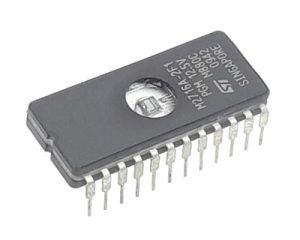
What is the EEPROM?
Electrically erasable programmable read-only memory is referred to as EEPROM. It is a type of memory chip that retains data even after being turned off. EEPROM can be reprogrammed by wiping off the data on a computer or specialized device. Typically, plug-and-play uses it. The contents of EEPROM (electrically erasable programmed read-only memory), which can be a non-volatile memory that preserves its contents despite changes in capacity, are erased using an electrical signal. It keeps a little quantity of data for the BIOS of laptops and computers. Definitely a replacement for PROM and EPROM.
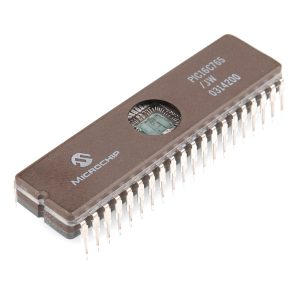
Video related to EPROM vs. EEPROM
EPROM vs. EEPROM Characteristics
| EPROM | EEPROM | |
| Features |
|
|
| Performance | Since EPROM is a non-volatile rewritable memory chip, its data won't be lost if the power is turned off. It is programmed using an EPROM programmer, which can supply a greater voltage than the device's typical operating voltage. Only intense UV light may be used to delete an EPROM once it has been programmed. The ceramic EPROM package features a tiny crystal window for erasing. The normal covering for this quartz glass is tape with an opaque adhesive. When erasing, remove the adhesive tape and expose the surface for roughly 20 minutes to a powerful UV light. | An electrically erasable programmable read-only memory, or EEPROM, will retain its data even if the power is turned off. Like EPROM, EEPROM is read-only in normal conditions. A high voltage can be provided to the pin chosen to write or erase when writing is necessary, and the erasing speed is rapid. The two main categories of EEPROM chips are serial EEPROM and parallel EEPROM. While reading and writing, serial EEPROM uses a 2-wire, 3-wire, 4-wire, or SPI bus interface for data input and output. A parallel bus is used for data input and output. |
| Applications | Switch setup parameters for a small system, such as baud rate, synchronous and asynchronous selection, data length, and other parameters, can be saved in EEPROM, and a data sequence or table can be created so that users can quickly make their choice. The specified working mode is set each time the CPU is turned on in accordance with the specifications stored in the EEPROM. Control data including channel configuration, data rate, and terminal durability can be shown on the CRT as a table for large-scale computers and communication networks. On the CRT, the system can be readily set. The reliability and flexibility of the communication network are no longer an issue thanks to the effective storage of this data and tables. | A typical type of memory is EPROM. Typically, it serves as program memory in the design and operation of single-chip microcomputers. Actually, it is a programmable logic device as well. It can be used to construct complicated measurements and control procedures in addition to logic functions. Liquid crystal displays, which are typically used in digital voltmeters, have poor brightness and low numbers. |
| Working principle | The tunneling phenomenon, which allows electrons with energy below the energy barrier to pass through the barrier and reach the other side, is used to write an EEPROM. According to quantum physics, when an object's physical size is similar to the electron-free range, the electrons will show fluctuations, which in this case indicates that the thing should be small enough. | The majority of BIOS ROM chips on later motherboards use EEPROM instead of EPROM due to the inconvenience of EPROM operation. EEPROM does not require the use of other devices to erase, is the smallest unit of modification byte, and is completely unrestricted by the limitations of EPROM Eraser and Programmer. All of the data need not be cleaned in order to be written. |
Pros and cons of EEPROM and EPROM
| Pros and cons of EEPROM |
| Pros of EEPROM: |
| There is no need for additional equipment in order to replace the contents. |
| There are several types of electrical interfaces, including serial bus and parallel bus. |
| EEPROM may be programmed indefinitely many times. |
| Erasure is done instantly and electrically. |
| You can choose to delete a specific byte or the full contents of the EEPROM. |
| Without removing it from the board or test jig, it is very simple to program and wipe the contents of the EEPROM. The circuitry needed to program and delete the EEPROM is built into the board itself by the designers. |
| Cons of EEPROM: |
| Different voltages are needed for erasing, reading, and writing data in EEPROM. |
| For the majority of devices, the EEPROM has a 10-year maximum data retention period. |
| Long access times are required for external serial EEPROM types. Therefore, it is advised to choose the proper EEPROM type based on the intended use. |
| Compared to PROMs and EPROMs, EEPROM devices are more expensive. |
| Pros and cons of EPROM |
| Pros of EPROM: |
| Even without power, it can maintain memory. Consequently, no external memory is needed. |
| It can be reprogrammed, as was already explained. |
| It is quite economical. |
| Cons of EPROM: |
| Like an EEPROM, it is impossible to remove a specific byte; instead, the entire contents are erased. |
| To delete or reprogram an EPROM, the device must be taken off of its board or test jig. |
| Unlike EEPROM, which can be erased instantly, UV-based EPROM takes some time. |
| EPROM transistors have higher resistance. |
| It uses a lot of static power. |
| The program can only be removed through UV light exposure; electrical signals cannot do this. |
The structure of EPROM and EEPROM
A programmable device is a PROM. The two-layer poly structure is used in common goods like EPROM and EEPROM. A programmable device, an EPROM uses a double-layer gate (two poly) structure, the main one of which is seen in Figure 1. When the voltage is provided to the control gate but there is no electron injection in the floating gate, the floating gate's electrons go to the upper layer and holes develop in the bottom layer. Electrons are subsequently drawn to the induction, which opens the channel. The trench closes if electrons are injected into the floating gate, increasing the threshold voltage of the tube. The trench is sealed off. The switching function is thus accomplished.
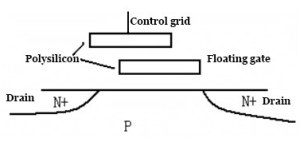
How does EPROM work?
Figure 4 illustrates the EPROM writing procedure, which involves applying a high voltage to the drain while completely opening the channel for electron passage from the source to the drain. Due to the high voltage's effects on electrons, their tension is heightened and their temperature rises dramatically, turning them into hot electrons. When a high voltage is supplied to the control grid, the hot electrons are able to cross the SiO2 barrier and are injected into the floating grid because they are rarely impacted by the scattering brought on by the atoms' vibration. The electrons are firmly held when no other outside pressures are present. The electrons are exposed to ultraviolet light when they need to be removed, giving them the energy they need to break free from the floating gate. The tunneling phenomenon, wherein electrons with less energy than the energy barrier can pass the barrier to the other side, is used in the EEPROM writing process.
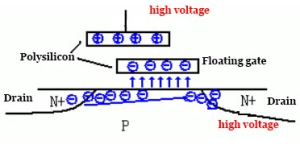
How does EEPROM work?
Operating with an EPROM is a pain. The majority of the motherboard's BIOS ROM chips now employ EEPROM (Electrically Erasable Programmable ROM). There is no need for additional hardware to erase EEPROM. It modifies its content via electronic impulses, using bytes as the smallest unit of modification. The EPROM Eraser and programmer can be totally removed without the need to wash all the data before writing. When writing data to EEPROM, a specific programming voltage is still required. Currently, the manufacturer's unique refresh program makes it simple to rewrite the information.
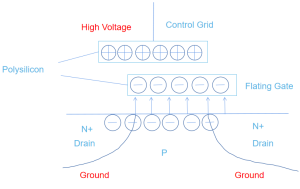
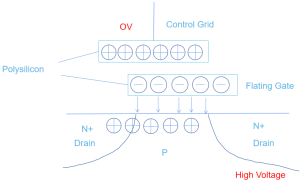
EPROM vs. EEPROM
| EPROM | EEPROM |
| The EPROM chip needs to be disconnected from the circuit in order to erase and reprogram the system's BIOS. | Erase and reprogramming operations can be carried out without turning off the system's electrical circuit. |
| An erase in an EPROM takes 15 to 20 minutes to complete. | An erasure in EEPROM takes 5 milliseconds to erase the contents. |
| Hot electron injection programming is utilized in EPROMs. | The tunnel effect is a programming method for EEPROM. |
| The EPROM transistor requires 12.5 volts to operate. | The EEPROM transistor requires 5 volts to operate. |
| EPROM memory can be reprogrammed after being deleted. | Like EPROM, EEPROM is also reprogrammed after being erased. |
| The external programming is an EPROM. | The external programming is an EPROM. |
| An updated form of PROM is an EPROM. | The contemporary equivalent of EPROM is EEPROM. |
| 1 is the relative size of an EPROM cell. | In an EEPROM, each cell has a relative size of 3. |
| A window made of rock crystal is part of EPROM. | EEPROM is completely encased in a casing made of opaque plastic. |
| In an EPROM, the content is deleted using UV light. | The electric signal is utilized in EEPROM to erase the memory's contents. |
Conclusion of EPROM vs. EEPROM
An EPROM is a modernized version of a PROM, while an EEPROM is an EPROM's contemporaneous equivalent. An EEPROM cell's relative size is 3, compared to an EPROM cell's relative size of 1. To wipe and reprogramme the computer's BIOS, the EPROM chip must be disconnected from the computer circuit, whereas the EEPROM chip will be erased and reprogrammed inside the electrical circuit. EPROM and EEPROM were developed to overcome the problems with ROM and PROM. Using EPROM and EEPROM to remove and reprogram data offers chip reusability at a significantly faster and lower cost than using the limited advantages of ROM and PROM. A modified variant of PROM and ROM is EPROM. EEPROM, on the other hand, is an improved version of EPROM.
EPROM vs. EEPROM FAQ
EPROM vs. EEPROM
An EEPROM is the current equivalent of an EPROM, which is a more advanced form of PROM. The relative size of an EEPROM cell is 3, while that of an EPROM cell is 1. While the EEPROM chip will be deleted and reprogrammed inside the electrical circuit, the EPROM chip needs to be detached from the computer circuit in order to wipe and reprogram the BIOS.
What are the advantages of EPROM over EEPROM?
While EEPROM memory can be reprogrammed after being erased (like EPROM), EPROM memory cannot be once it has been erased.
What is EEPROM vs EPROM vs PROM?
While EPROM is a programmable ROM that may be wiped and reused, PROM is a Read-Only Memory (ROM) that can only be updated once by a user. On the other hand, EEPROM is a user-modifiable ROM that can be repeatedly wiped and reprogrammed using a regular electrical voltage.
What are the disadvantages of EPROM?
UV-based EPROM requires some time to erase, in contrast to EEPROM, which may be done quickly. Similar to an EEPROM, the entire contents must be erased in order to delete a single byte.
Why use EEPROM over Flash?
EEPROMs have a lifetime capacity of 1,000,000 erase/rewrite cycles. Depending on the type of Flash memory, Flash devices have a short lifespan; the majority of Flash products can endure 10,000–1,000,000 erase/write cycles before wear starts to compromise the storage's integrity.
